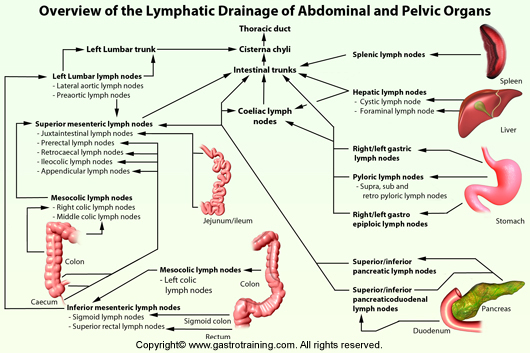Lymphatic system and abdomen
Discuss the function of lymphatic system?
- Transport of tissue fluid formed in the capillary bed. Interstitial fluid derived from blood bathes the cells and provides oxygen and nutrients to the cells and then most of the fluid passes back into the bloodstream carrying carbon dioxide and waste products. An amount of this interstitial fluid is drained by the lymphatic system.
- Lymph nodes perform a filtering function by removing harmful substances (bacteria, virus etc) from the interstitial fluid
- Most of the lymphocytes are formed in the lymph glands
- Intestinal lacteals help in the absorption of fat and protein from food (this gives lymph fluid the rich milky colour)
Discuss the major lymphatic channels?
Thoracic duct- this is the largest lymphatic channel in the body extending from L1 to the root of the neck. It begins as either a plexus by the confluence of several lymphatics on the posterior abdominal wall or a dilatation termed the cisterna chyli. It drains lymph from the left arm (via left subclavian), left neck and head (left jugular, left thorax, left upper abdomen (to umbilicus), both sides of the abdomen below the umbilicus and both lower limbs. It terminates either into the junction of the left internal jugular and subclavian veins or one of those veins.
Right lymphatic duct- It drains right head, neck, right arm (via right jugular trunk), right thorax (via right subclavian trunk) and right upper abdomen to umbilicus (via right Brachiocephalic trunk). It drains into the junction of the right internal jugular and right subclavian veins or each of these veins separately.
Discuss the abdominal lymph nodes?
They lie in front of the lumbar vertebral bodies near the aorta and are in three groups: preaortic, paraaortic and retroaortic
Preaortic nodes: lie in front of the aorta near the vessels of the name
Coeliac- drain gastric, hepatic and pancreaticosplenic node
Superior mesenteric- drain nodes in the mesentery
Inferior mesenteric- drain nodes in the mesentery
Efferent vessels from pre aortic nodes form intestinal trunks and help in the formation of the thoracic duct
Paraaortic nodes (left and right) – drains kidneys, adrenal glands, ureter, posterior abdominal wall, testis, ovary, uterus and uterine tubes.
External iliac lymph nodes receive lymphatics from inguinal nodes, external genitalia, vagina, and cervix; they drain into the common iliac nodes. Internal iliac and sacral lymph nodes receive afferents from all the pelvic viscera (e.g., cervix, prostate, and rectum) and from the perineum, buttock, and thigh; they drain into the common iliac nodes. Common iliac lymph nodes drain the two preceding groups and send their efferent’s to the paraaortic nodes, which also receives the afferents of the testis and ovary.
Efferent’s from paraaortic nodes form paired lumbar trunks. The lumbar trunks empty in the cistern chyli. Cisterna chyli is a dilated sac at the lower end of the thoracic duct.
Retroaortic Lymph Nodes – these nodes drain the posterior abdominal wall. These may be the peripheral nodes of the paraaortic group

Useful read: Link






